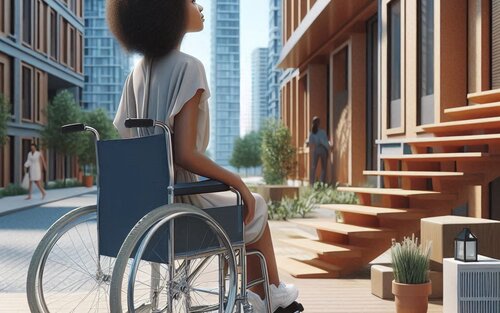Elements of a Disability Inclusive Conference
Kenya, Nairobi specifically plays host to many local, regional and international conferences and workshops. Ensuring inclusivity and accessibility in such spaces is not just a matter of compliance but a moral imperative. Such platforms offer invaluable opportunities for learning, networking, and professional development. However, for individuals with disabilities, these events can often present significant barriers which hinder their full participation.

Inclusive Spaces for people with wheelchairs
Here’s a comprehensive guide to making conferences and workshops inclusive and accessible for every disability.
Elements of an Inclusive Conference
1. Before the event
· OPD Involvement
Involving or engaging persons with disabilities, through their organizations is the most important consideration of an inclusive event. Disability is evolving, what works today will not work tomorrow. Persons with disabilities will offer insights and resources gotten from their lived experiences which will help in greatly enhancing inclusivity and accessibility of the events.
· Needs Assessment
Conducting surveys or reaching out to registered attendees to understand their specific needs is a proactive approach allows organizers to tailor accommodations effectively, especially for exclusive events. For events that are open to everyone, all accessibility considerations need to be in place and organizations of persons with disabilities can help guide this process.
· Communication and Information Access
If participants must register for the event, provide accessible applications forms. The online application forms should be simple to navigate. It should not request for too much information all at once, if it does, it should have an option of saving the work and resuming later.
The form should also allow the participants to state their disabilities and request for reasonable accommodations. There should also be an option of requesting for reasonable accommodations without disclosing the disability.
Provide materials in multiple formats, such as large print, Braille, and digital copies compatible with screen readers. Ensure that all pre-event communications, including emails and promotional materials, are accessible.
· Venue Selection
Accessible venues contribute a lot to the participation of persons with disabilities. There are different things to consider when selecting the venue, these are,
- Location of the venue – should be in an easily accessible environment and have plenty of space for wheelchairs to move around.
- Accessible Directions – directions to specific rooms, for example, washrooms should be clearly labelled.
- Availability of reasonable accommodation and assistive technology e.g listening devices, sign language interpreters, visual aids among many others.
- Quiet Rooms
- Ramps and Elevators - for individuals with mobility impairments.
- Accessible Restrooms - equipped with handrails and sufficient space for wheelchair users.
- Parking and drop-off points-designated accessible parking spaces close to the venue entrance.
- Seating arrangements - flexible seating plans to accommodate wheelchairs and care givers.
· Staff Training and Speakers Sensitization
Train all event staff and volunteers on disability awareness and etiquette. This includes understanding the needs of people with different disabilities and knowing how to offer appropriate assistance.
2. During the Event
Sign Language Interpreters and Captioning
Offer sign language interpreters for live events and provide real-time captioning for presentations. This aids attendees who are deaf or those with varying hearing impairments.
Assistive Listening Devices
Provide devices that amplify sound for individuals with hearing impairments. Ensure these devices are readily available and easy to use.
Visual Aids and Presentations
Make presentations accessible by using high-contrast slides, large fonts, and clear, simple layouts. Verbalize all visual information for those who are blind or have low vision.
Readily Available human Assistance
Arrange for on-site assistance to help attendees navigate the venue. This could include volunteers or staff members trained to assist individuals with mobility challenges. This may include serving them during meal breaks.
Quiet Rooms
Provide quiet spaces for attendees who may need a break from sensory overload, such as those with autism or anxiety disorders. Ensure these rooms are easily accessible and well-publicized.
Inclusive presentations
Inclusive presentations should include,
Text and Background Contrast: Use high-contrast colour schemes, such as dark text on a light background or light text on a dark background, to ensure readability.
Font Choices: opt for sans-serif fonts like Arial, Verdana, or Tahoma, which are easier to read on screens. Avoid decorative fonts that can be difficult to decipher.
Font Size: use large font sizes, typically no smaller than 24 points for body text, to ensure visibility from a distance.
3. After the event
· Additional Resources
In cases where the presentations and other documents are not shared before the meeting, they can be shared after the meeting.
· Feedback Forms
Gather feedback from attendees with disabilities to continually improve accessibility efforts for future events.
Article by: Emomeri Maryanne
